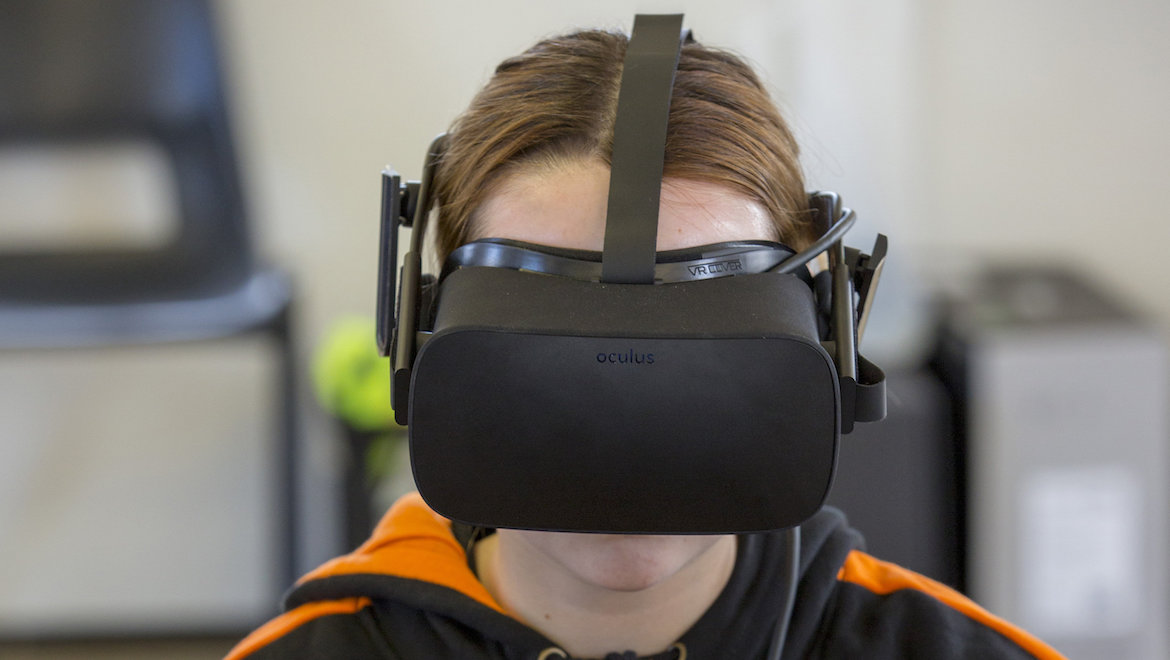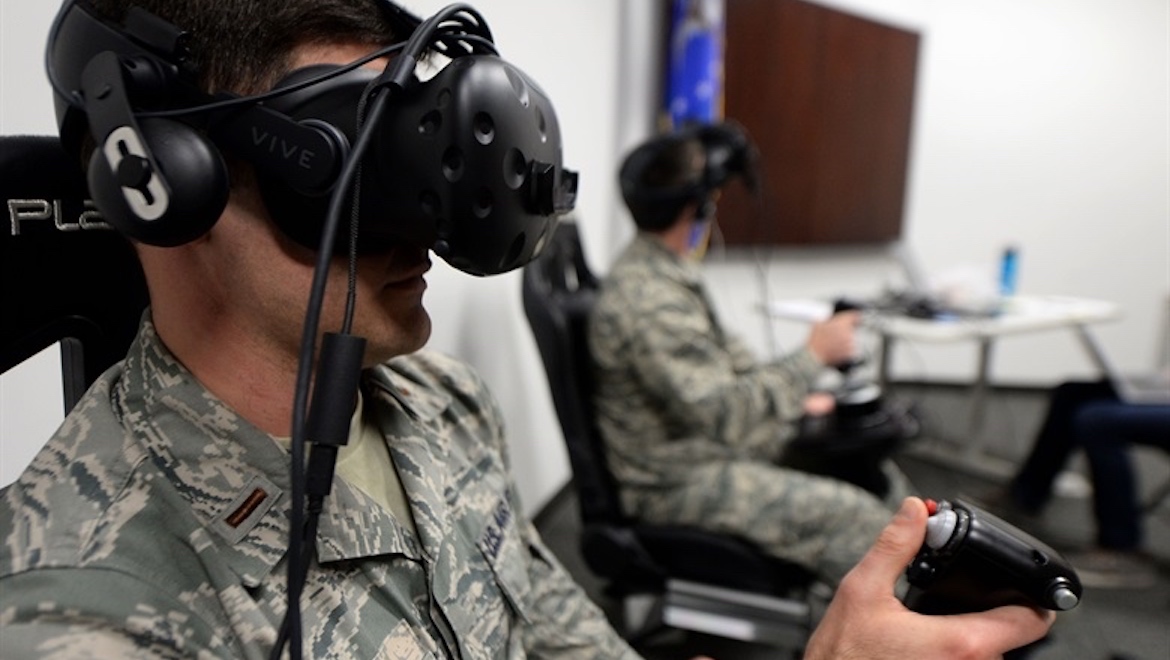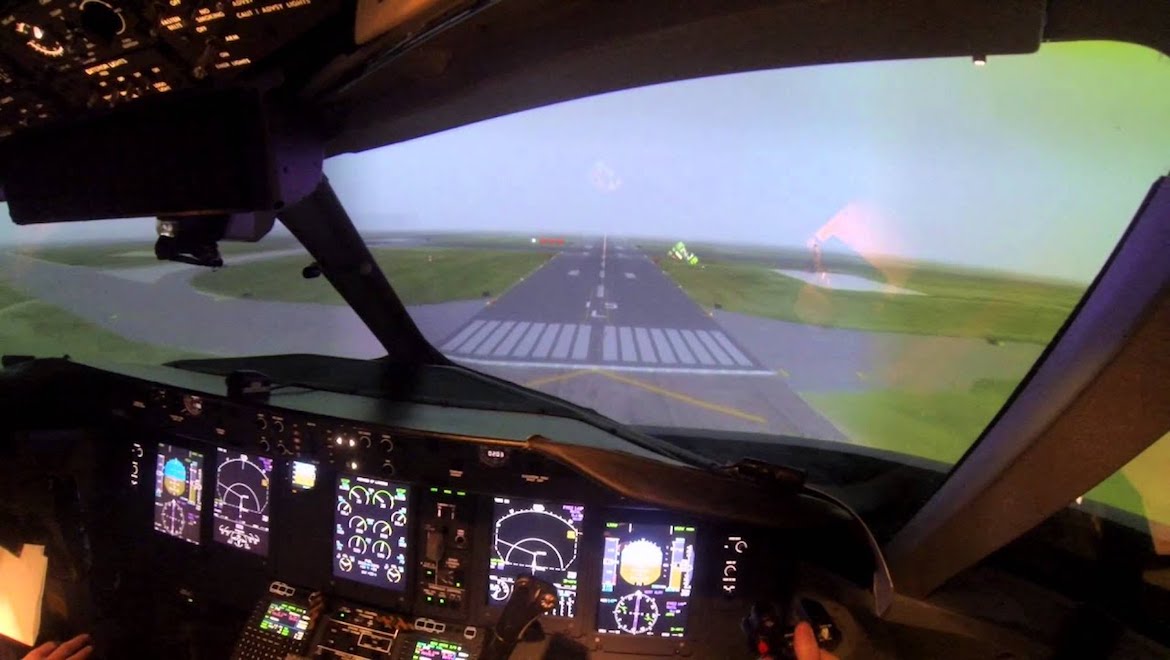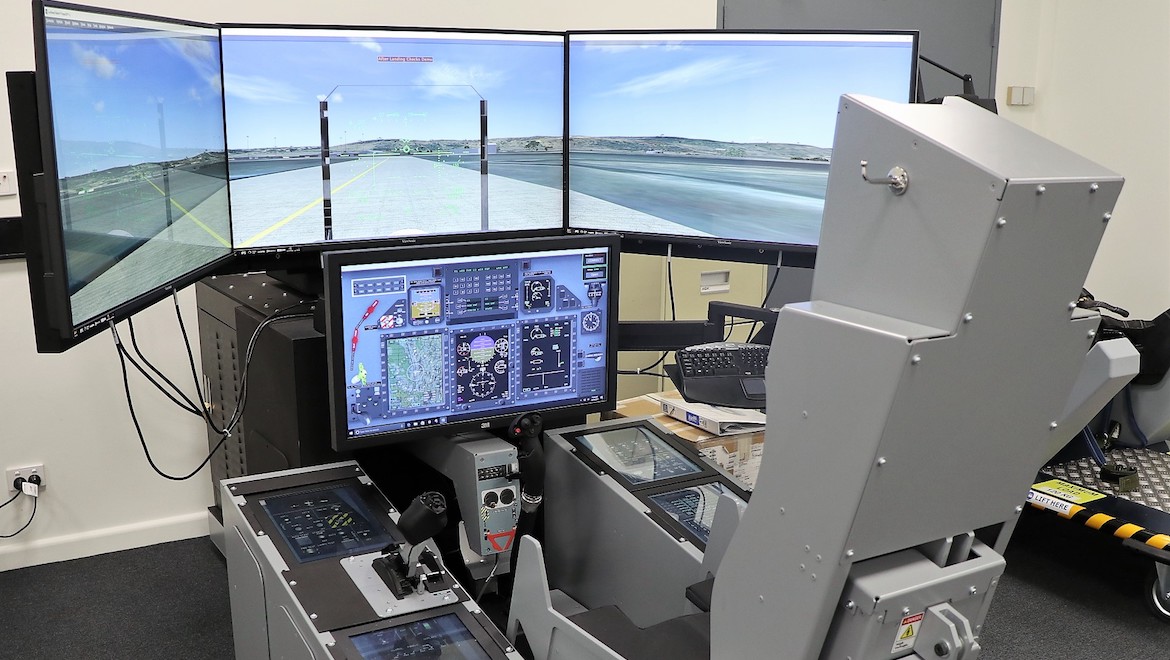This story about flight training first appeared in the July 2019 edition of Australian Aviation.

Is aviation training keeping up and delivering training outcomes that align with new simulation technology and learning methods? In Australia, many companies and learning institutions such as Boeing Training, airlines, general aviation flight schools, universities, and the Australian military are embracing the new sim technology and the training methodology that goes with it.
New high-fidelity equipment has arrived on the Australian market during the past 12 months for use across the aviation industry. Adopting new technology allows operators and airlines to integrate media suites and high-fidelity simulators into their training systems to increase competency via an improved transfer of learning. For example, a Cessna 172 high-fidelity simulator transfers learning to the aircraft better than, say, a generic GA device. The flow-on effect of improved, and indeed more affordable simulators, will result in a reduction in training costs as students complete their training more efficiently.
For many years, airlines have worked with type-rating training organisations using high-fidelity simulators in other parts of the world. Countries that don’t have the luxury of pilots joining airlines with thousands of hours in the logbook have needed a method to increase the competency of pilots with more limited experience.
High-fidelity training has provided the answer. Training programs such as the jet orientation/multi-crew cooperation (JOC/MCC) integrated type rating has seen a leap forward in increasing pilot competency among those with less experience. Evidence-based training programs take full advantage of the suite of technology, developing training outcomes around manoeuvres and various scenarios.
In Australia, recent new simulation technology assisting in competency-based training includes full-flight zero motion flight training devices (FTDs). Australia has seen FTDs before but not high-fidelity devices that have all the elements of a full-flight simulator (FFS). Two examples of FTDs in Australia are the Q400 and B737NG FTD. They allow operators to integrate JOC/MCC and type rating for lower experienced pilots to gain competency in a more linear fashion allied to the specific type of aircraft they will fly. The JOC/MCC plus type rating is a longer course, however, with crew learning on a type-specific FTD from the start, transferring the basics of their multi crew training into the type rating, thus delivering an efficient and quality result for the airline. The crew will have the advantage of an extra 20hrs on type prior to starting line training. Although JOC/MCC is not regulated as type-specific, the crew’s transfer of learning is greater than if they had completed only JOC/MCC on a non-specific device.
From the commercial perspective, blending FTDs with FSSs allows an operator to reduce costs without compromising quality. It is possible to run half the full-flight sessions in the FTD thereby increasing training capacity by 50 per cent. This blend of technology has been available in Europe for many years with manufacturers such as The Netherlands’ Multi Pilot Simulations (MPS) extending airline and other training operators’ FFS capabilities. This capability now exists in Australia with the first MPS full-flight zero motion B737NG FTD1 and QantasLink’s Q400 FTD.

Safety first
New simulation technology assists us in many forms, from iPad computer-based training to full-flight simulator capability. Making use of simulation technology allows for deeper understanding, skills development, and evidenced-based outcomes essential to aviation safety. Safety is always our number one priority – as an industry, organisation and as individuals. It is, therefore, in everyone’s interest to use the best training tools, technology and learning methods at our disposal.
As pilots, we strive to perform at our best; to be professional and disciplined. We invest in apps to help us study and increase our knowledge. We use our cockpit posters to run drills and, these days, some form of personal simulation to prepare for our training flights or recurrent checks.
We have used a form of “blended learning” since we first started as a student pilot, using media in the shape of books, videos, posters, pilot guides and computer-based training. So what else can we access that is new today in the blended learning suite? Has the range of available “mixed media” changed over the past 20-30 years? Of course it has. Technology and learning methods have evolved and we now understand, more than ever, how we learn as individuals. Industry is working towards new concepts around training for aircrew using new technology to help pilots and businesses stay safe and profitable.
Most change is around the vast personal media suite now available and accessible in the home, online, even before we arrive at the training centre or place of work. Videos and print material are now embedded into mobile computer-based learning suites with the added benefits in some cases of virtual or augmented reality elements to produce an immersive experience. We can see our next lesson and “fly” through the syllabus in a virtual reality with our instructor talking us through the procedure, blending our learning as we progress outside to the simulator or aircraft. The personal learning suite has prepared us to start the high-fidelity phase of training.

Supporting training methodologies with an alternative suite of learning tools
The industry faces several challenges in training, from training demands themselves to the economic perspective of running a business.
A traditional training syllabus leaves little room for tailoring content and adapting to generational changes in learning. Industry needs to look at changes in demand and styles of learning, and call for flight training tools to evolve. With the introduction of new training methods, simulation technology and advanced media tools, we have the opportunity to address some of these industry training challenges.
Modern learning and training methodologies develop almost as rapidly as simulation technology. Sometimes, learning tools and methods develop together and, usually, we adapt our learning to technological change. A good example of this is Upset Recovery Training (UPRT). The technology in simulators was developed from working groups, aircraft manufacturers and regulators to provide the tools and methods to prove a “situation or show evidence” to crew of an upset recovery scenario. Simulation is great, low risk, informative and positive in addressing a serious industry risk such as UPRT. That said, simulation can only goes so far in replicating real world “aircraft” feel and performance. For example, no-one has taken a 777 so far out of the normal flight envelop that they would live to tell the tale and record the flight data. The industry has introduced a methodology for UPRT early in flight training so it can be learned in a realistic environment
as a core understanding in basic flight training. Our regulators mandate to ensure we are developing these skills in both basic and advanced flight training.
Concepts of UPRT can be also demonstrated as part of blended learning: through emerging technology such as virtual reality, prior to manual control manipulation in a simulator or aircraft.
Our current technology can be broken into training media and simulation, providing part-task and whole-task training. Training media takes the form of mobile and interactive learning devices on tablets and PCs, interactive class rooms, virtual reality and other digital means. Part-task training platforms such as FTDs, desk top FMS trainers and virtual reality procedure trainers, gradually build a partial skill and knowledge base to ultimately perform a whole-task. Part-task training, when using high-fidelity advanced media and simulators, allow us to develop the competency and deep knowledge base to perform whole-task training and checking. Whole-task training using FSS and aircraft allows for manual manipulation training and checking.
Other non-technical skills can be developed in part-task training, such as workload management, teamwork, and decision-making, before transfer to a fully realistic whole-task training environment for practice and assessment.
Two phases of training can follow the concepts of using part-task and whole-task trainers: manoeuvres and scenarios that incorporate competencies defined by regulation. Examples of how to use part-task and whole-task training:
- OBSERVE on alternative media and PRACTICE on part-task trainers for regulator-based malfunction training.
- PRACTICE manoeuvre training on high-fidelity FTDs or, if necessary, in an FFS.
- PRACTICE and ASSESS the integration of these skills and competencies in integrated complex line scenario training in the FFS.

(Nick Kranenburg)

(Nick Kranenburg)
Training evolution concept
We’ve talked about new simulation technology, accessing a range of training tools, and using new methods. Now let’s look at adoption of “advanced training media” in a blended training system. The objective is to deliver an aircrew with better learning outcomes, and the operator or airline more efficient use of simulation, instructor time and knowledge base.
The European Aviation Safety Agency (EASA) has issued a concept paper in relation to evidence-based and competency-based training (alternative training media and methods).
We all accept that different students learn differently and at different speeds. Traditional education of “one size fits all” is progressively being questioned with slow implementation of education practise that focuses and adapts to individual student needs. Adaptive learning is part of this concept, using different training media and providing students with the opportunity to practice in different ways and scenarios.
“Adaptive learning is an educational method which uses computers as interactive teaching devices and orchestrates the allocation of human and mediated resources according to the unique needs of each learner.” (Wikipedia).
The potential benefits of modern and adaptive training media are:
- Involvement of the pilot in his/her own progress instead of following a fixed path where the pilot is required to learn a fixed amount in a particular order. These tools may allow them to slightly modify the amount of knowledge they learn in the different areas and in what order.
- Possibility to adapt the learning methodology to the pilot’s need.
- Possibility to adapt the learning speed to the pilot’s need.
- Possibility to use different training media adapted to the pilot’s need.
- Possibility to schedule training on a continuous basis for whole year, instead of having six to 12-month windows. New training media and methods allow flexible training solutions that are not fixed to particular date/s. Instead they allow training through the year.

An example of a new concept? Regulation requires crew in an operator recurrent training program to be competent in upwards of 50 different approaches in a three-year cyclic program. Training and checking requirements, such as performance-based navigation, special approach requirements such as NVIS, EVS, HUD and so on put pressure on the training program. FFS or FTD provides a high-fidelity environment for performance of these tasks, but some hardly need interaction with the aircraft. An alternative method of training could be used if the fidelity is guaranteed.
An example of possible use of alternative training media concept? Auto-land with visual reference established at DH following an instrument approach. Although this is a checking requirement, it may be possible to increase the validity period of some tasks in the simulator by acceptable training means.
An example of a CAT IIIB environment requires the crew to monitor the autopilot performing an auto-land. While visual fidelity is required physical control functionality may not be. In this type of approach, a virtual reality device demonstrating the environment might all be that is needed.
A military application is also possible, for example in formation flying. A high risk, high-fidelity environment requires aircrew to develop procedures, manual handling skills and visual cues to undertake formation flying to a high level of safety and competency. While the manual manipulation of flight controls is essential in the aircraft, developing the procedures and visual cues could begin in a virtual reality environment. Students could be exposed to formation flights in the virtual world in a two-ship or more formation, the exercise demonstrating various formation positions and re-joins. With the knowledge of the instructor recorded in the VR environment, the student can gain procedural knowledge and visual cues prior to getting into the aircraft or FTD. It’s another example of blended learning with further training undertaken in the aircraft for manoeuvre competency and assessment.
Most syllabuses and flight scenarios can be replicated in VR. The concept of recreating a real-time flight scenario is now possible with the instructor delivering recorded information. This creates some key advantages in using VR media training in a blended training system:
- Standardisation with each student getting the same instruction.
- With pressure on instructor resources, instructor’s knowledge is saved and delivered in VR.
- The student can access the instructor knowledge in VR at any time, over and over.
Getting the training evolution balance right is a key challenge. Regulatory requirements have unwittingly overloaded FFS simulator training sessions. The use of FFS is not always the most efficient use of valuable and experienced resources, including our instructors. On the other side of the coin, economic pressure may lead some operators to the cheapest possible delivery method, thus reducing the investment into alternative training tools and progressing to best practise.
A balanced approach is best illustrated with Ryanair, a low-cost carrier that has invested in training tools to support an efficient training system, regulatory requirements, younger pilots with low experience, and demand. Aircrew have access to controlled training in FTDs for informal learning prior to re-currency, allowing aircrew to manage learning through a defined set of goals set by the company. Other informal learning can take on forms of e-learning, virtual procedures and enriched training scenarios in the FTD.
With all the new technology and training methods we use today and will into the future, it is important we measure the effectiveness and efficiency of instructional course design and delivery. Course designers could select the most appropriate devices including alternative media, virtual reality, fixed-based devices and full-flight simulators that comply with regulatory requirements and complement the training and commercial outcomes of the organisation.
The designers need to constantly evaluate for training effectiveness in light of feedback, current training needs, educational best practises and technology potential.

Nick Kranenburg is the managing director and training manager at SimJET Flight Training.
This story first appeared in the July 2019 edition of Australian Aviation. To read more stories like this, subscribe here.














Damien Wills
says:Great article Nick! At GoFly Aviation we have also embraced blended learning, providing our students with access to over 120 videos for their RPC, Cross Country, Passenger endorsement and Instructor Rating AND we also incorporate time in the simulator, into their training to make them better pilots. These videos at http://www.goflyonline.com.au can be watched in VR headsets and in 360-degree video if students desire, and can be purchased by any aspiring pilot or flight school, anywhere in the world. More content is added weekly and will include GA training and theroy. The pre-flight and inflight videos speed up the understanding of concepts and can be used to refresh their memory, at any time before or after a lesson. We believe that the more videos, VR and sim use a student has, the better pilot they will be.